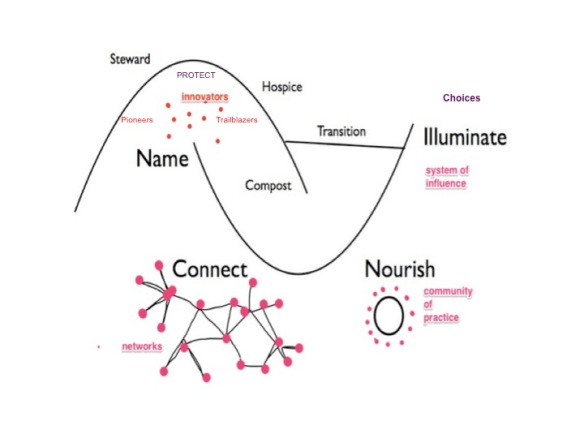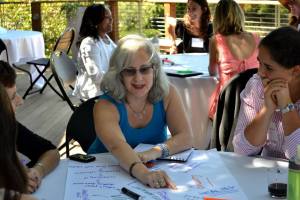In my twenty years of consulting practice the idea that our systems are broken and need to be fixed has been ever-present. This was/is true of healthcare, finance, the environment and more. This has never been more true in my life time than right now when the question maybe is not about whether systems are broken but whether they are dying. Dying as part of normal, natural cycles of birth, growth, decay and death, including the last desperate gasps.
In the work I have been involved with over the last two decades (change management, systems thinking, strategic direction and culture shift), there has always been a curiosity and, more accurately, a fear about whether systems need to collapse entirely before something new emerges. We constantly want to fix things – systems, organizations and even (maybe especially) people.
Yet we know in times of crisis normal patterns of relationship can be interrupted; rules, policies, procedures and ways of working circumvented and results achieved faster than in normal, day to day circumstances where, even if the pace is fast, things do not seem to be accomplished quickly. These are conditions that consultants and organizations all over keep trying to replicate without crisis with varying degrees of success and more often failure.
Jerry Nagel and I often remind our clients that systems are perfectly designed to get the results they are getting and cultures are self-perpetuating. So, technically, the systems aren’t broken, but many are no longer delivering results we hope for or are satisfied with. Brexit, the US election, are perfect examples.
What happens, might happen, in total collapse? What ground would we stand on? How would we pick up the pieces and move forward? What if the collapse is so great there are almost no pieces to pick up – like the scenarios in the popular genre of dystopian novels and movies? In most works of fiction, no matter how desperate the aftermath of catastrophe, there are always some pieces to pick up.
Lately we have been using the 2 Loops of Systems Change, offered by Meg Wheatley and Deborah Frieze of the Berkana Institute, with our clients and there is an immediate resonance with the concepts and roles described.
Systems work in cycles – just like life itself. The length of time of the cycles may vary from a few years to decades to centuries and maybe even eons. There is a time of birth, growth, maturity, decay and eventually death. Think, for example, of farming. Originally it was hunter/gather, then people began to deliberately plant crops and farming in the form of small farms existed for a long time. It grew into industrial farming where it is almost impossible to sustain smaller farms. And we are back to a point where people want to track their food from farm to table, plant community gardens and eat organic.
New life is already being brought forth long before death, during the maturity or peak phase of a system. The seeds of the new already exist within the structures of the old. 
Innovators, trail blazers and pioneers are always playing around with new ideas. Some of those new ideas seem completely off the wall to many who are still reveling in the old system and do not yet see the need for the new or innovation. Think energy. During the oil crisis back in the 1970s and 80s, there was speculation that oil had peaked. During that time, there were people and small companies experimenting with other forms of energy – solar, wind, water. It was slow going for decades, some of the experimentation was expensive and there was not a lot of support for ideas that seemed crazy or impossible to some, especially to those attached to the old system. Forty years later, many of these forms of energy are now more cost effective and environmentally friendly than oil. It was not easy to see or believe in this possible future at the time.

Embodying the 2 Loops of Systems Change
Innovators are often alone in their quests and many of their ideas fail. Since no idea is offered in complete isolation – others are also conceiving of ideas to address the same or similar challenges – a first step is in naming the innovators and beginning to connect them in networks. In this way they begin to learn with and from each other. They learn together through both success and failure and they are no longer in it alone.
As the need for innovation becomes more apparent and urgent, there are people within the mature or peak system who take notice and work within the current system to steward or champion the new ideas and the people who generate them to provide protection so this work can continue to advance. Sometimes the role is as a toxic handler – to keep the dysfunctionality of a system that is moving past its prime from interfering in the development of the new.
At the same time, one of the greatest roles in the mature system as it declines is in hospicing the old so it doesn’t completely collapse into chaos and so that that good is not thrown out with what no longer works. The biggest challenge in these days is who are the protectors, the stewards, the hospice workers? Will they/we be able to do this work or will the burden be too great, the rate of collapse now so swift that it will be a deep move into chaos?
As the tentative new innovations and ideas gain more strength and more form, as they begin to coalesce into new networks and communities of practice, it is critical to nurture the emerging life force that will influence and shape the new system. As momentum grows, this grows into a system of influence where choices become clear. Illuminating the choice between the old and the new gives curious and reluctant adopters of the new the opportunity to make this choice and as more and more people choose the new, the new system takes hold.
While I carry some anxieties in these early days of 2017 about our systems and our future, I also carry hope although I am not sure what it will take to release the old and gravitate toward the new. I do know 2017 is calling on us loud and clear to not be silent, to not just watch, but to stand up and be involved in the new systems that will call forth and support our humanity.
The pressing question in the days ahead is who are the innovators and trailblazers? How do we keep connecting people, ideas and networks in ways to build strength, momentum and opportunity? How can the old systems of influence, and people grasping for power, be prevented from crushing the new? And how do we create the stories of the new in ways that brings more people on board.
Are our systems failing us? The answer would appear to be yes. But not because they are broken, because they are coming to the end of their time. Will we be courageous enough to fight if necessary for what is waiting to be born?

















